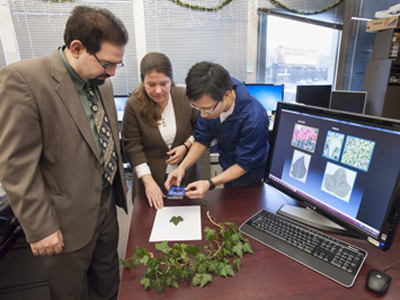Press Release: Carnegie Mellon Researchers Lead Collaborative Team Developing Digital Mapping of Poisonous Plants
System Will Be Available as Smartphone or Tablet App
Contacts: Chriss Swaney / Carnegie Mellon / 412-268-5776 / swaney@andrew.cmu.edu
Leigh M. Kish / Carnegie Museum of Natural History / 412-622-3361 / kishL@carnegiemnh.org
 PITTSBURGH—Carnegie Mellon University researchers and a botany expert from Carnegie Museum of Natural History are developing a digital system for identifying poisonous plants.
PITTSBURGH—Carnegie Mellon University researchers and a botany expert from Carnegie Museum of Natural History are developing a digital system for identifying poisonous plants.
"These plants are in our backyards and often wind up on our patios and even in our living rooms to add color during drab winter weather, so we really need to be aware of their impact on our health," said Marios Savvides, director of the CyLab Biometrics Center at CMU.
Working with Cynthia Morton, head of the botany section of Carnegie Museum of Natural History, researchers identified 35 poisonous plants and created profiles of each plant.
"We are developing a comprehensive digital database with all the most dangerous plants and how these plants impact human health," Morton said. "Because plants can't move to escape their predators, they must have other means of protecting themselves. Some plants have physical defenses such as thorns, but by far, the most common protection is chemical and that's where the poisonous plants come into play," Morton said.
For centuries, poisonous plants have played key roles as culprits in myths and mysteries. The poison hemlock, for example, is allegedly the plant used to poison Greek philosopher Socrates in 399 B.C. In late January, more than a dozen Wyoming school students were rushed to the hospital after eating uncooked yuca root. While the potato-like plant is a staple in many underdeveloped countries when cooked, if the roots are eaten raw, the plant is potentially toxic.
Morton points out that another dangerous plant for teenagers is datura, a big white flower whose seeds are harvested for its hallucinogenic value.
"This new digital system will be an excellent way to inform the public and keep track of all the various symptoms from contact with certain toxic plants," said Anthony F. Pizon, a physician in the Division of Medical Toxicology in the Department of Emergency Medicine at the University of Pittsburgh and a medical director of the West Virginia Poison Center.
While deaths from poisonous plants are rare, Morton said the ability to map and track when these plants intersect with large segments of the population is critical to public safety.
"We are still building the system, which will be available as a smartphone app or tablet app, which we eventually want to make available to every hospital emergency room in the nation," Savvides said.
Additionally, the researchers want to make the app as simple to use as taking a smartphone picture of a leaf. The app would identify the plant and list the plants' appearance, toxicity and remedy/antidote for health care professionals to administer.
"We are looking to extend this to more poisonous plants and poisonous mushrooms, which is the next computer vision/pattern recognition challenge. I also envision this as a smartphone app that may evolve to a stage where it detects a poisonous plant in the wild (nature trails), saves its GPS location and provide a continuous updated social network map of user-sited poisonous plants. The map would be used in the wild by hikers and nature enthusiasts during their outdoor activities, and by poison control centers, hospitals and botany centers," Savvides said.
Early research funding for the project came from the UPMC Healthcare Technology Grant program to advance new areas of research in health care information technology. The program, which began in 2010, is a strategic collaboration between UPMC and CMU.
###
Above, Mario Savvides, Cynthia Morton and a CMU student take a smartphone photo of ivy, which can be poisonous if injested.